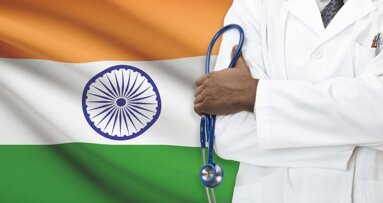The second full budget of the Modi 3.0 came in a little more than 6 months; the first being on 23rd July 2024. The huge expectations from the middle class were finally fulfilled as the Union Budget 2025 heralded significant changes in personal income taxation, notably raising the tax exemption threshold. The Budget 2025 presents a blend of immediate relief measures and strategic investments whilst addressing the concerns of the middle class and aiming for fiscal consolidation. It talks of its vision of Viksit Bharat 2047 and Healthcare is an important sub-component of Viksit Bharat but what does ‘Viksit Bharat’ actually mean and contain?
The vision for Viksit Bharat 2047 encompasses 6 subheads viz.:
-
- Zero-poverty;
- 100% good quality school education;
- Access to high-quality, affordable and comprehensive healthcare;
- 100% skilled labour with meaningful employment;
- 70% women in economic activities; and
- Farmers making our country the ‘food basket of the world’.
For India to compete, it must transition from being the ‘pharmacy of the world’ to the ‘innovation engine of the world.’
Innovation in healthcare is not just an economic opportunity but a valiant necessity like, for example, while innovation is the cornerstone of the healthcare future, it can’t flourish without world-class infrastructure. As a healthcare sector inclusive myself, my few pertinent questions would be:
-
-
- Is it a balanced budget?
- Does it address something substantial in healthcare?
- Is there any new allocation for healthcare?
- Does it address the Ayushman Bharat initiative in the long term? and the most important,
- Does it succumb to the pressure of being a populist budget for the middle class vs. continuing the reforms in previous budgets in line with the ‘Viksit Bharat 2047’ dream?
Let us see further!!
Prelude
The pre-budget Economic Survey 2024-25 (a day before the Budget) highlighted the importance of lifestyle choices for mental health while pointing out that individuals who avoid ultra-processed foods and lead active lives tend to have better mental well-being. Conversely, spending long hours in sedentary activities like dentistry, desk jobs or excessive social media use negatively impacts mental health. The report emphasised the need for preventive strategies to improve mental well-being, particularly for India’s youth, underscoring the importance of addressing mental health as part of the nation’s economic strategy. The Economic Survey also indicated that despite the government's ambitious expansion of medical education, it remains unaffordable for many, pushing thousands of students abroad to low-cost destinations like China and Russia. Even as the number of doctors grows, a severe imbalance persists; rural areas remain underserved and specialisations such as psychiatry and geriatrics are neglected. Meanwhile, low remuneration and better opportunities abroad are driving Indian doctors to migrate, creating a global workforce at India's expense.
Prologue
The Budget 2025 was a ‘GYAN’-oriented Budget - spanning ten broad areas focusing on Garib, Youth, Annadata and Nari, and it has called out Education and Skilling as a key area of Investment rather than Expenditure, which recognises the transformative potential of human capital in India. The broad announcements in the healthcare space revolved around strengthening the Anganwadi programme and Poshan 2.0, expanding the capacity of medical colleges, setting up world-class skilling centres and creating a centre of excellence for AI in Education to provide a balanced approach towards transforming education in India. The increase in allocation for education also indicates a clear intent to invest in the future of the youth in India and build a strong platform for Aatmanirbhar Bharat.
Although we can discuss the whole budget at length, for the sake of this review, let us keep our focus limited to healthcare:
Allocation
-
-
- The budget allocation for the Department of Health & Family Welfare (DoHFW) increased by 92% from Rs. 47,353 crore in 2017-18 to Rs. 90,958.63 crore in the July Union Budget 2024-25.
- In the Budget 2025, the government, while prioritising expanding medical care and infrastructure, has set aside Rs. 98,311 crore for the development, maintenance and enhancement of the country’s healthcare system in the upcoming financial year, up by 9.8 percent from the previous fiscal year, a slight increase from the previous year; although this figure is still modest compared to nations like the US and Germany, where healthcare accounts for over 10% of GDP.
- Additionally, Rs. 2,445 crore has been earmarked for the Production-Linked Incentive (PLI) scheme aimed at boosting the pharmaceutical industry, a 191% increase in budgetary allocation from FY14-15.
- From the above allocation for health this year, Ayushman Bharat Pradhan Mantri Jan Arogya Yojana (AB PM-JAY) got an allocation of Rs. 9,406 crore.
- The government has allocated Rs. 4,200 crore for the Pradhan Mantri Ayushman Bharat Health Infrastructure Mission (PMABHIM).
- The government has allocated Rs. 37,226.92 crore to the National Health Mission (NHM).
- The National Tele Mental Health Programme was allocated Rs. 79.6 crore.
- The Union Budget allocated Rs. 20,046.07 crore for autonomous bodies.
- The allocation for All India Institute of Medical Sciences (AIIMS), Delhi, was increased to Rs. 5,200 crore.
Salient features:
-
-
- Focus on Health and Education: The Government has recognised that a healthier and better-educated population is vital for sustained economic growth and thus, accordingly, the Budget reflects major investments in the health and education sectors.
- The Saksham Anganwadi and Poshan 2.0 programme provides nutritional support to more than 8 crore children, 1 crore pregnant women and lactating mothers all over the country and about 20 lakh adolescent girls in aspirational districts and the north-east region, and the cost norms for the nutritional support will be enhanced appropriately.
- All primary healthcare centres and government secondary schools will be equipped with broadband connectivity.
- 50,000 Atal Tinkering Labs will be set up in Government schools in the next five years to cultivate the spirit of curiosity and innovation and foster a scientific temper among young minds.
- The Government has added almost 1.1 lakh UG and PG medical education seats in ten years, an increase of 130%. In the next year, 10,000 additional seats will be added in medical colleges and hospitals, towards the goal of adding 75,000 seats in the next five years to help improve the doctor-patient ratio and make both secondary and tertiary care more accessible and affordable. Every additional medical seat also translates to the addition of four beds to the medical college and hospital. In five years, this initiative would add 3 lakh more beds, nearly 1/3rd of the current capacity in the public sector. The government will consider expanding existing medical colleges wherever possible to optimise expenditure rather than open new medical colleges for this endeavour.
- Recognising the contribution of gig workers, the Government will arrange for their identity cards and registration on the e-Shram portal and they will be provided healthcare under PM Jan Arogya Yojana (PMJAY); thereby assisting nearly 1 crore gig workers. Gig workers are employed by on-demand companies and brands like Zomato, Swiggy, Amazon and Flipkart etc. to provide services to the latter’s clients. The PMJAY is the largest health assurance scheme in the world, which aims at providing a health cover of Rs. 5 lakh per family per year for secondary and tertiary care hospitalisation to over 12 crore poor and vulnerable families.
- Medical Tourism and Heal in India will be promoted in partnership with the private sector along with capacity building and easier visa norms. Promoting medical tourism boosts a country’s economy by attracting international patients, increasing foreign exchange earnings and creating jobs in healthcare and hospitality and also fostering global collaboration, improving medical research and expertise.
- In the next five years, under the PM Research Fellowship scheme, 10,000 fellowships will be provided for technological research in IITs and IISc with enhanced financial support. The 2nd Gene Bank with 10 lakh germplasm lines will be set up for future food and nutritional security and provide conservation support to both public and private sectors for genetic resources.
- Day Care Cancer Centres in all district hospitals will be set up in the next three years in all district hospitals to improve the accessibility of cancer care in India, of which 200 Centres will be established in FY 2025-26 itself. This will strengthen cancer care infrastructure, reducing mortality rates and improving patient outcomes.
- According to the National Centre of Disease Control (NCDC), in 2022, the projected number of new cancer cases in India was 14,61,427, with a crude incidence rate of 100.4 per 1,00,000 individuals. This rate of 100 cancer cases per 1,00,000 people, in relative terms, might be lower than in many countries like the U.S., which reports more than 300 cases per 1,00,000. However, in absolute numbers, the burden is very high given India’s large population. Also, approximately one in nine people in India is expected to face a cancer diagnosis during their lifetime. Similarly, around 70 million (7 crore) Indians are estimated to suffer from rare diseases in India as per ICMR. The projected cancer burden in India is expected to rise from 26.7 million DALYs (adjusted mortality to incidence) in 2021 to 29.8 million in 2025, with the highest burden in the north and north-east regions. To provide relief to patients, particularly those suffering from cancer, rare diseases and other severe chronic diseases, 36 life-saving drugs and medicines will be added to the list of medicines fully exempted from Basic Customs Duty (BCD), which will provide a huge relief for cancer patients and even to those suffering from rare diseases and chronic conditions.
- These 36 drugs are Onasemnogene abeparvovec, Asciminib, Mepolizumab, Pegylated Liposomal Irinotecan, Daratumumab, Daratumumab subcutaneous, Teclistamab, Amivantamab, Alectinib, Risdiplam, Obinutuzumab, Polatuzumab vedotin, Entrectinib, Atezolizumab, Spesolimab, Velaglucerase Alpha, Agalsidase Alfa, Rurioctocog Alpha Pegol, Idursulphatase, Alglucosidase Alfa, Laronidase, Olipudase Alfa, Tepotinib, Avelumab, Emicizumab, Belumosudil, Miglustat, Velmanase Alfa, Alirocumab, Evolocumab, Cystamine Bitartrate, CI-Inhibitor injection, Inclisiran, Agalsidase Beta, Imiglucerase and Eptacog alfa activated recombinant coagulation factor VIIa. This list covers a broad range of medicines, particularly those used in the treatment of rare genetic disorders, cancer and immunological conditions. Among the key beneficiaries are Onasemnogene Abeparvovec (treatments for spinal muscular atrophy and a gene therapy medication), Velaglucerase Alpha (Gaucher disease Type 1), Miglustat (Gaucher disease Type 1), Risdiplam (SMA), Spesolimab (generalised pustular psoriasis), Rurioctocog alfa pegol (haemophilia A), Olipudase alfa (Acid sphingomyelinase deficiency – ASMD), Mepolizumab (eosinophilic asthma), Belumosudil (chronic graft-versus-host disease - cGVHD and Pompe disease), in oncology, Daratumumab (used for multiple myeloma), Atezolizumab (used for various cancers), Teclistamab for multiple myeloma, Spesolimab (inflammatory diseases), Alirocumab (primary hyperlipidaemia), Evolocumab (manage cholesterol levels) and Inclisiran (high levels of low-density lipoprotein (LDL) - cholesterol management); these reduced prices will make long-term treatments more affordable for patients.
- Earlier in the 2024 budget and before that, customs duties on 4 drugs viz. Trastuzumab Deruxtecan, Osimertinib, Durvalumab and Pembrolizumab (Keytruda), a Merck cancer drug commonly prescribed in India for breast cancer, lung cancer, bladder cancer and cervical cancer respectively were reduced from 10% to zero as they are fully exempted from basic customs duty.
- Besides, the government will add SIX MORE life-saving medicines to a list with a concessional customs duty of 5%, making essential medicines more affordable; the list is awaited. Full exemption and concessional duty will also respectively apply on the bulk drugs for manufacture of the above.
- Budget 2025 has provided a full exemption from basic customs duty to patient assistance programmes (PAPs) run by pharmaceutical companies, provided they supply medicines to patients free of cost. In addition to the above point, the government will add 37 new medicines and 13 new patient assistance programmes to the exemption list.
- These 37 drugs are: Pembrolizumab Key, Pembrolizumab KIRAN, Lorlatinib, Dacomitinib, Inotuzumab Ozogamicin, Ribociclib, Dabrafenib, Selumetinib, Benralizumab, Fulvestrant, Acalabrutinib, Olaparib, Amivantamab, Teclistamab, Ustekinumab, Daratumumab + Hyaluronidase-fihj, Ibrutinib, Bortezomib, Daratumumab, Cetuximab, Avelumab, Tepotinib, Brentuximab Vedotin, Vedolizumab, Velaglucerase Alpha, Agalsidase Alpha, Idursulphase, Mepolizumab, Alectinib, Risdiplam Powder, Emicizumab, Atezolizumab, Pertuzumab + Trastuzumab, Ocrelizumab, Polatuzumab Vedotin, Faricimab and Luspatercept. Among the key beneficiaries are Polatuzumab Vedotin for lymphoma and cardiovascular therapies), Teclistamab for multiple myeloma, Atezolizumab (used for various cancers), Mepolizumab (eosinophilic asthma), Risdiplam (SMA), Velaglucerase Alpha (Gaucher disease Type 1) and Daratumumab (used for multiple myeloma) etc.
Postlude
The increase in medical seats is a welcome move but the government will have to improve the existing infrastructure of medical colleges and increase faculty numbers to keep pace with the growing number of students. Additional seats in medical institutions will though help reduce the dominance of the private sector in this field but simply increasing the number of medical seats without adequate hospitals with modern facilities for practical training and qualified instructors will render theoretical classes alone as ineffective.
The Economic Survey indicated that affordability remains a key issue as well; while government medical colleges have lower fees, private institutions, which offer almost half of all MBBS seats, charge ‘high fees’. High fees in private medical colleges, often in the range of Rs. 60 lakh to Rs. 1 crore, make medical education unaffordable for many students. Efforts to cap fees for 50% of private medical seats have not significantly changed the situation. As a result, many Indian students opt for medical education abroad in countries like China, Russia, Ukraine and the Philippines, where fees are lower. Every year thousands of students go abroad to around 50 countries, especially those with lower fees. However, this trend not only drains financial resources but also presents uncertain career prospects. Many Foreign Medical Graduates (FMGs) struggle to pass India’s licensing exams, with the survey noting that only 16.65% of students cleared the Foreign Medical Graduate Examination (FMGE) in 2023.
The Economic Survey also pointed out that, even as the number of doctors rises, their distribution remains imbalanced as rural areas remain underserved. The doctor-patient ratio in urban areas is significantly higher than in rural regions and with 75% of dispensaries and 60% of hospitals in urban areas, where 80% of doctors serve, fresh graduates continue to gravitate towards cities where infrastructure, salaries and career opportunities are more appealing. The expansion of medical education has done little to address this imbalance, leaving many rural populations without adequate healthcare.
The Economic Survey said there is also an imbalance in the choice of specialisations as well. Fields like radiology, dermatology and gynaecology attract more students, while areas such as psychiatry, geriatrics and emergency medicine are neglected and the shortage of specialists in these fields could grow. This is concerning, given India’s ageing population and increasing mental health needs. Without policies to encourage students to pursue these specialisations, the country may face a shortage of specialists in crucial areas.
Remuneration for doctors further complicates the situation. Fresh MBBS graduates in India earn an estimated Rs. 5 lakh per year, while senior doctors earn Rs. 12.5-18.4 lakh; salaries that can be comparable to or lower than those in other sectors. With limited financial incentives, many doctors seek opportunities abroad. The OECD (Organisation for Economic Co-operation and Development) countries reported in 2021 that there were close to 19,000 physicians from India in their workforce, and migration in 2021 alone was over 2,800 physicians. This trend raises concerns about India’s investment in medical education, as it supplies a trained workforce to foreign healthcare systems. Meanwhile, quality control in medical education also remains a challenge despite regulatory oversight, as in spite of the elaborate regulations and monitoring, issues like shortage of faculty, ghost faculty, low patient load in hospitals, etc., continue to affect the quality of training, and enforcement of measures such as Aadhaar-based attendance tracking and CCTV monitoring has remained inconsistent.
Epilogue
The healthcare allocation has increased by 10% this year, showing the government’s commitment to the sector. Overall, the Budget 2025 continues the positive path for healthcare innovation and infrastructure growth in India. Proper management of fiscal policies can significantly improve the national financial health, while poor management can lead to instability. It will be crucial to see how essential services like education, health, and subsidies are managed in this budget.
Conclusion: A budget for growth, stability and inclusivity
The Budget 2025 delivers a comprehensive vision for India’s future of Viksit Bharat 2027. It focuses not only on driving economic growth but also on ensuring that this growth is inclusive and sustainable. From infrastructure development to nuclear energy, taxation reforms to social welfare, this budget sets the stage for a stronger, more resilient economy. As India steams through the challenges of the global economy, this budget offers a pathway that combines modernisation with inclusivity, striking a delicate balance between driving innovations and maintaining social welfare, and the coming financial year promises to be one of opportunity, as India paves its way towards becoming a global economic powerhouse.
Topics:
Tags:
Dr. Bhavdeep Singh Ahuja analyzes the first full budget of the Modi 3.0 government, highlighting its significant impact on the healthcare sector. The health...
Dr. Bhavdeep Singh Ahuja graduated in 1998 from Punjabi University, Patiala. He has specialized in Implants from BioHorizons Inc. USA in 2004-05 & in ...
COVID-19 is having an unprecedented impact on the global economy, including that of the dental industry. Most dental clinics are shut and a few are offering...
COVID-19 is having an unprecedented impact on the global economy, including that of the dental industry. Most dental clinics are shut and a few are offering...
COVID-19 is having an unprecedented impact on the global economy, including that of the dental industry. Most dental clinics are shut and a few are offering...
COVID-19 is having an unprecedented impact on the global economy, including that of the dental industry. Most dental clinics are shut and a few are offering...
COVID-19 is having an unprecedented impact on the global economy, including that of the dental industry. Most dental clinics are shut and a few are offering...
New Delhi: In a significant policy move, the Indian government announced a ₹500-crore scheme to fortify the domestic medical device sector. The ...
Out of Rs 90,658.63 crore allocated for the health ministry, Rs. 87,656.90 crore has been allocated to the Department of Health and Family Welfare while Rs ...
The key themes that stand out from the budget announcements are a big focus on capital expenditure, promoting a greener economy, leveraging the impact of ...
Live webinar
Wed. 14 January 2026
10:30 pm IST (New Delhi)
Dr. Théo Laplane, Dr. Robert Gottlander DDS
Live webinar
Fri. 16 January 2026
10:30 pm IST (New Delhi)
Live webinar
Mon. 19 January 2026
11:30 pm IST (New Delhi)
Philipp Kopp, Michael Seeber
Live webinar
Thu. 22 January 2026
7:30 pm IST (New Delhi)
Prof. Judith Jones D.D.S; M.P.H., Prof. Kakuhiro Fukai D.D.S., Ph.D, Dr. Bathsheba (Bethy) Turton
Live webinar
Fri. 23 January 2026
12:30 am IST (New Delhi)
Dr. Nicola M. Grande DDS, PhD
Live webinar
Wed. 28 January 2026
6:30 pm IST (New Delhi)
Live webinar
Wed. 28 January 2026
9:30 pm IST (New Delhi)
Prof. Dr. Jan-Frederik Güth



 Austria / Österreich
Austria / Österreich
 Bosnia and Herzegovina / Босна и Херцеговина
Bosnia and Herzegovina / Босна и Херцеговина
 Bulgaria / България
Bulgaria / България
 Croatia / Hrvatska
Croatia / Hrvatska
 Czech Republic & Slovakia / Česká republika & Slovensko
Czech Republic & Slovakia / Česká republika & Slovensko
 France / France
France / France
 Germany / Deutschland
Germany / Deutschland
 Greece / ΕΛΛΑΔΑ
Greece / ΕΛΛΑΔΑ
 Hungary / Hungary
Hungary / Hungary
 Italy / Italia
Italy / Italia
 Netherlands / Nederland
Netherlands / Nederland
 Nordic / Nordic
Nordic / Nordic
 Poland / Polska
Poland / Polska
 Portugal / Portugal
Portugal / Portugal
 Romania & Moldova / România & Moldova
Romania & Moldova / România & Moldova
 Slovenia / Slovenija
Slovenia / Slovenija
 Serbia & Montenegro / Србија и Црна Гора
Serbia & Montenegro / Србија и Црна Гора
 Spain / España
Spain / España
 Switzerland / Schweiz
Switzerland / Schweiz
 Turkey / Türkiye
Turkey / Türkiye
 UK & Ireland / UK & Ireland
UK & Ireland / UK & Ireland
 International / International
International / International
 Brazil / Brasil
Brazil / Brasil
 Canada / Canada
Canada / Canada
 Latin America / Latinoamérica
Latin America / Latinoamérica
 USA / USA
USA / USA
 China / 中国
China / 中国
 Pakistan / Pākistān
Pakistan / Pākistān
 Vietnam / Việt Nam
Vietnam / Việt Nam
 ASEAN / ASEAN
ASEAN / ASEAN
 Israel / מְדִינַת יִשְׂרָאֵל
Israel / מְדִינַת יִשְׂרָאֵל
 Algeria, Morocco & Tunisia / الجزائر والمغرب وتونس
Algeria, Morocco & Tunisia / الجزائر والمغرب وتونس
 Middle East / Middle East
Middle East / Middle East





























































To post a reply please login or register